Loch Katrine Cake, at first glance, would seem to be a traditional Scottish bake; after all, the name sounds like it’s straight out of the Highlands.
Perfect for us here at Scottish Scran. Excellent.
But hold on to your mixing bowls; the recipe’s origins are a surprise and couldn’t have been further from Scotland if it tried!
However, first, let us explain precisely what we’re talking about.
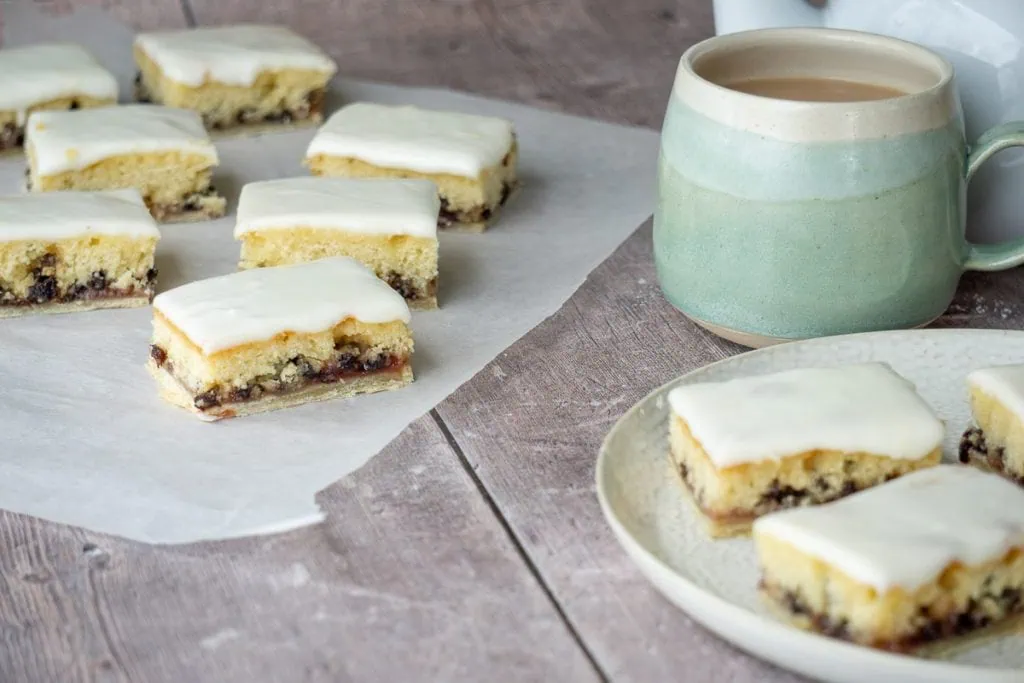
What is Loch Katrine Cake?
Loch Katrine cake is a delightfully simple layered tray bake featuring a thin pastry base that’s easy to make, accompanied by a layer of light sponge filled with currants.
The cake is all topped with a thin layer of lemon icing that helps break up the sweetness and add a wee zing.
Where is Loch Katrine Cake From?
This deliciously simple cake actually hails from New Zealand, not Scotland! It’s a recipe that Sonja and her family have grown up with, made for its deliciousness as much as for its simplicity.
So, how did it come to have such an obviously Scottish name?
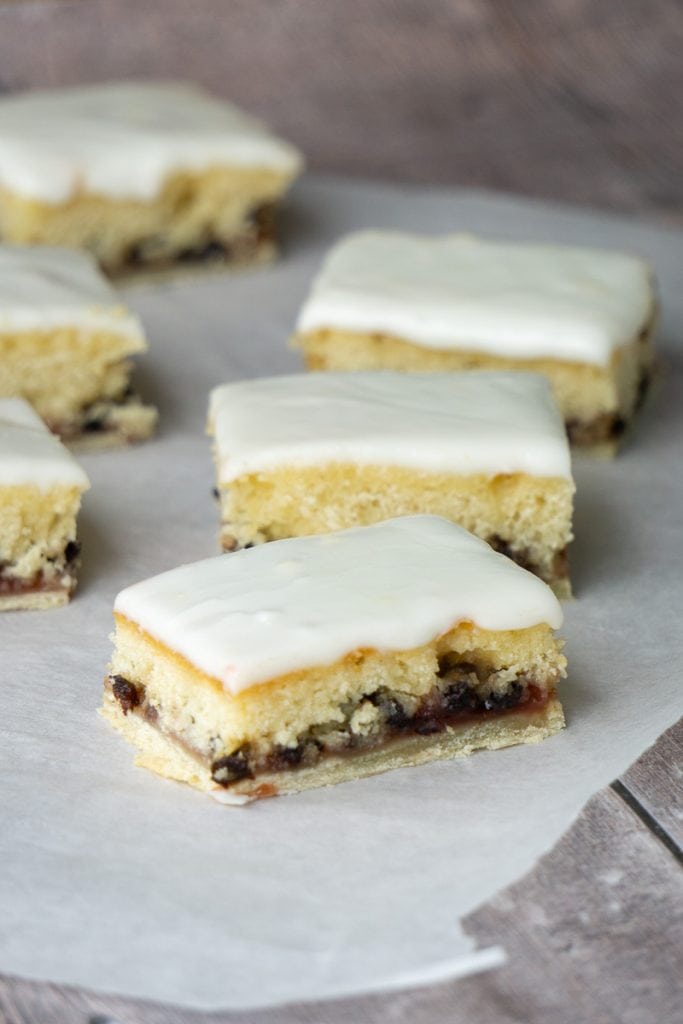
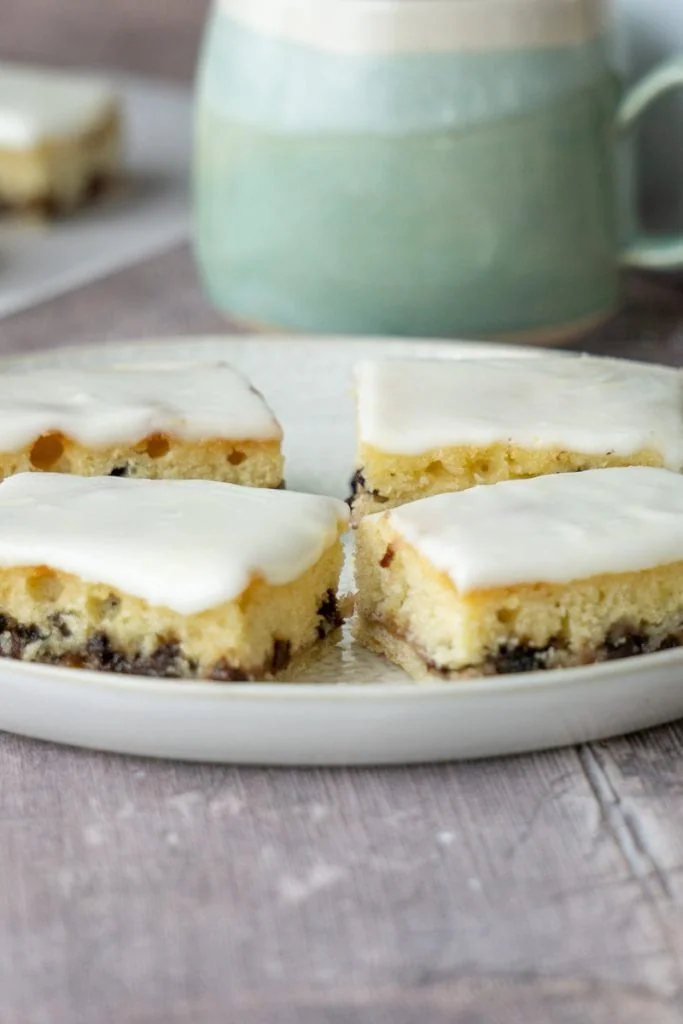
Why is it Called Loch Katrine Cake?
Let’s start on home soil before we head to the Southern Hemisphere. Loch Katrine in Scotland is a loch in the Trossachs, famously associated with Sir Walter Scott’s The Lady of the Lake and a source of water to Glasgow since 1859.
This makes Loch Katrine a pretty well-known loch, considering Scotland has 30’000 of them!
So, you would expect this to be where the cake has gained its name. And in a second-hand way, you would be right.
Sort of.
What you need to know is that nestled in North Canterbury, in New Zealand’s South Island, is a remote alpine lake, Loch Katrine, named by Scottish settlers who brought a piece of home with them across the world when they first began more organised migrating to New Zealand in the mid-1800s.
Around the same time, give or take a decade, the Scottish Loch Katrine would have been in the news about its new supply to Glasgow.
It should be noted that the lake is also known by its original Maori name, Waitetemoroiti. It is also worth noting that the Gaelic name for Loch Katrine is Loch Ceiteirein. Katrine is the modern English version and the name used in Scott’s poem.
After all that information about the name of the loch and, by default, the cake, there is no information as to why this tasty treat was named after Loch Katrine.
It first appears in New Zealand cookbooks; however, we can take a leap of faith to assume its origin and naming are due to the New Zealand body of water.
This all being the case, you could say that Sir Walter Scott and his popular poem were the reason Loch Katrine Cake got its name.
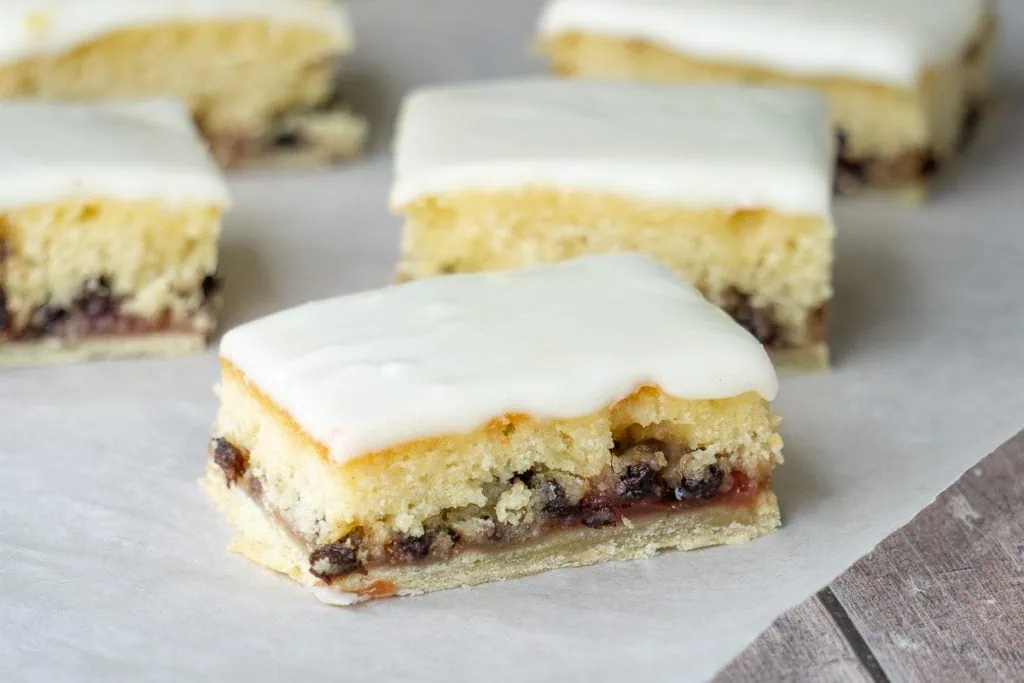
Why Make Loch Katrine Cake?
Why make Loch Katrine Cake? Because it is so deliciously tasty! The zing the lemon provides and the juice of the currants balance the sweetness of the sponge and icing.
Our kids thought this was one of the best things we’ve made, just sweet enough and wonderfully moreish.
Things You’ll Need to Make Loch Katrine Cake
The beauty of Loch Katrine Cake is in its simplicity. You don’t need anything fancy, just basic baking staples you already have in your kitchen. Here’s what you’ll need:
- Baking tray 30x22cm
- Sifter
- Bowl
- Clingfilm
- Wooden spoon
- Baking paper
- A little butter to grease the tin
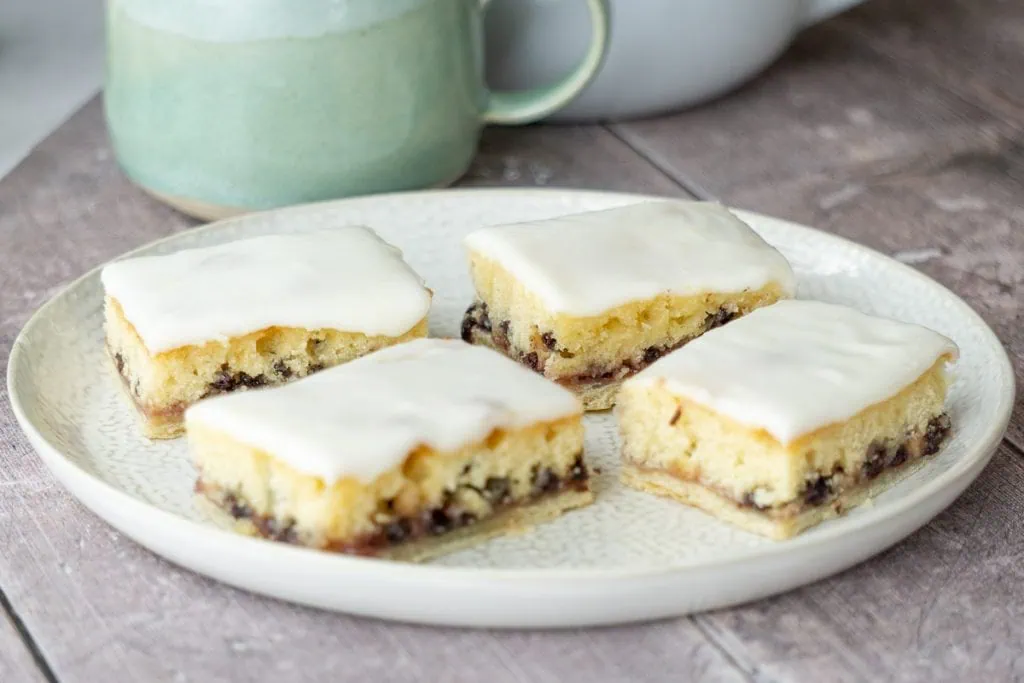
Ingredients for Loch Katrine Cake
Yield: 18 pieces approx
Prep time: 40 minutes
Baking time: 30 minutes
Base:
- 190g Plain Flour (1.5 cups)
- 2 tsp Baking Powder
- 90g Unsalted Butter, cold and cubed
- 4-5 tbsp Milk
- 3-4 tbsp Raspberry Jam
- 135g Currants (1 cup)
Sponge:
- 90g Unsalted Butter, room temp
- 150g Caster Sugar (3/4 cup)
- 2 tsp Baking Powder
- 190g Plain Flour (1.5 cups)
- 3 Medium Eggs
- 5-6 tbsp Milk
Icing:
- 350g Icing Sugar
- 3.5 tbsp Water/Lemon Juice (water for plain icing, lemon for lemon icing)
- 1 tsp Vanilla Essence (if you are not doing lemon icing)
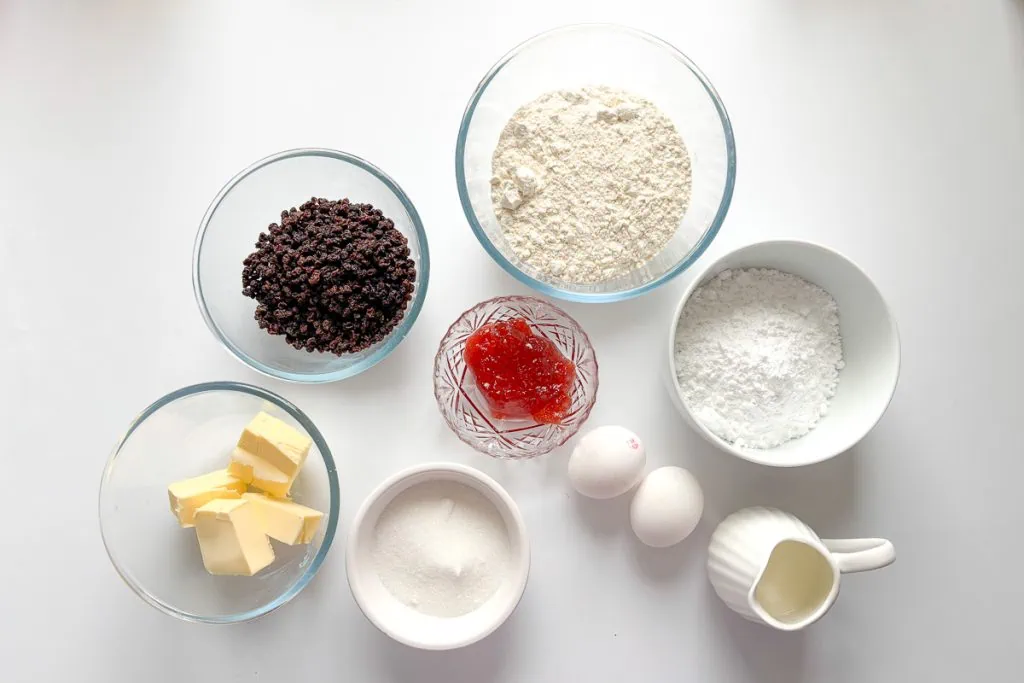
How to Make Loch Katrine Cake – Step-by-step Method
To start making Loch Katrine cake, we need to begin by making the pastry, which forms the base of the cake.
Sift the flour and baking powder into a mixing bowl.
Take your cold, cubed butter and rub it into the flour and baking powder mix slowly, using your fingers, until it resembles breadcrumbs.
Add milk gradually to make a stiff dough. You may need more or less milk depending on the mix. Work it slowly into the mix, stirring the milk and mixing together with a spoon or your hands. This will help avoid adding too much milk and making your dough too wet.

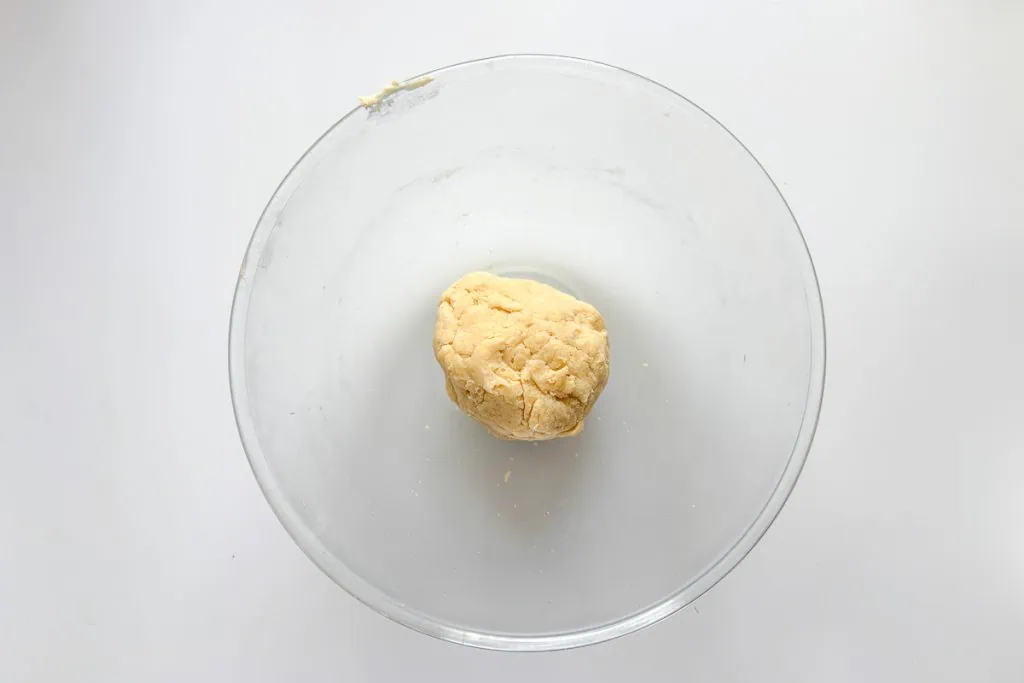
Once your dough is well mixed, your next step is to let it rest.
Wrap it in cling film and pop it in the fridge for 30 minutes. The reason you wrap the pastry is to prevent it from drying out.
Chilling the pastry allows the gluten in the flour to relax, and the fat to remain separate and firm when rolling it. This will help have a flaky and soft pastry once baked.
Grease and line your baking tin with baking paper, ensuring that you focus on the sides of the tin as well as the bottom.
Roll out your pastry after it’s chilled for 30 minutes, then use it to line the bottom of your greased tin. Cut off any excess.
Spread your raspberry jam evenly over the pastry, lightly covering the entire surface.
Sprinkle the currants onto the now jam-covered pastry, again trying to ensure an even spread.

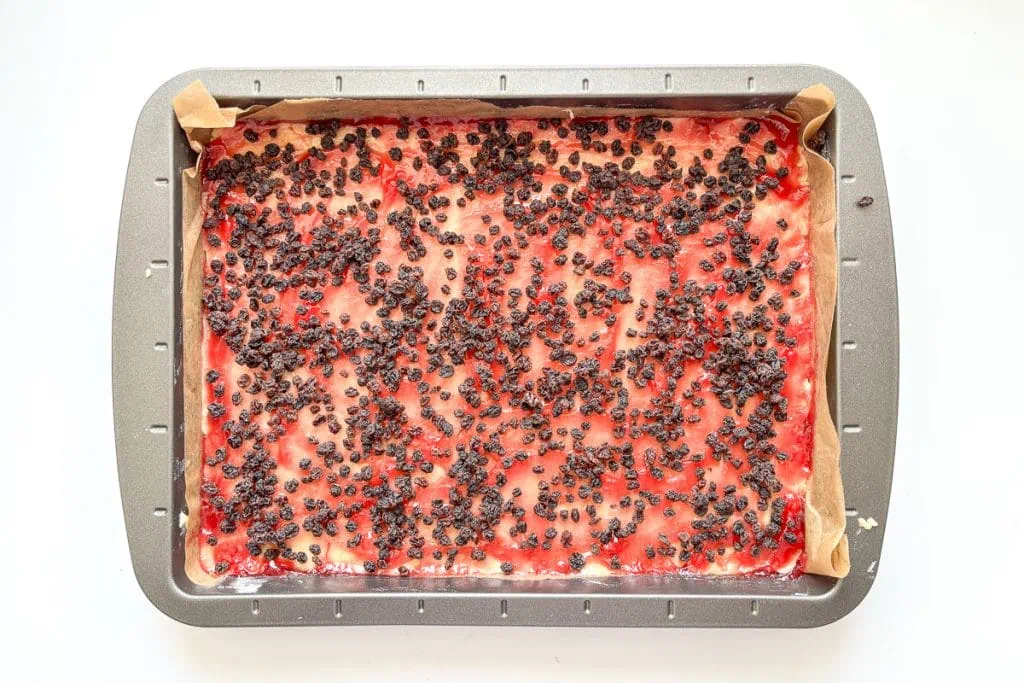
Preheat your oven to 180°C / 160°C for fan-assisted (365°F/320°F).
In a new bowl, cream the room-temperature butter and caster sugar. Once the mix is creamed into a paste-like consistency, beat in the eggs one at a time.
Add the flour and baking powder to the bowl and mix them together gently.
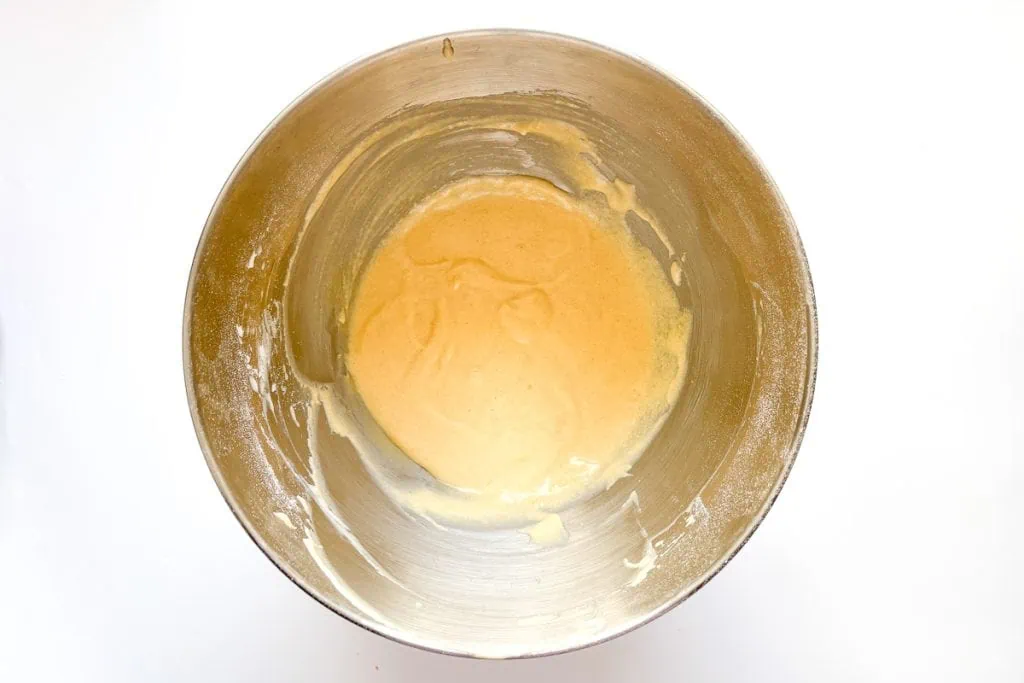
Pour this mixture into the baking tin and spread it evenly over the pastry.
Bake for 30-35 minutes; all ovens vary slightly. Test the sponge by inserting a knife into it after you think it’s cooked and looking to see that the knife comes out clean when removed.
Allow to cool fully in the baking tin, before icing.
For lemon icing, mix lemon and water with the icing sugar; for vanilla icing, replace lemon with vanilla essence. Do try it with the lemon icing, it really does add to the taste of the cake.
Once well mixed together, spread the icing over the sponge thinly while still in the baking tin.
Allow to set before lifting the cake out of the tin. We used a fish slice very gently to move the cake from the tin to a plate.

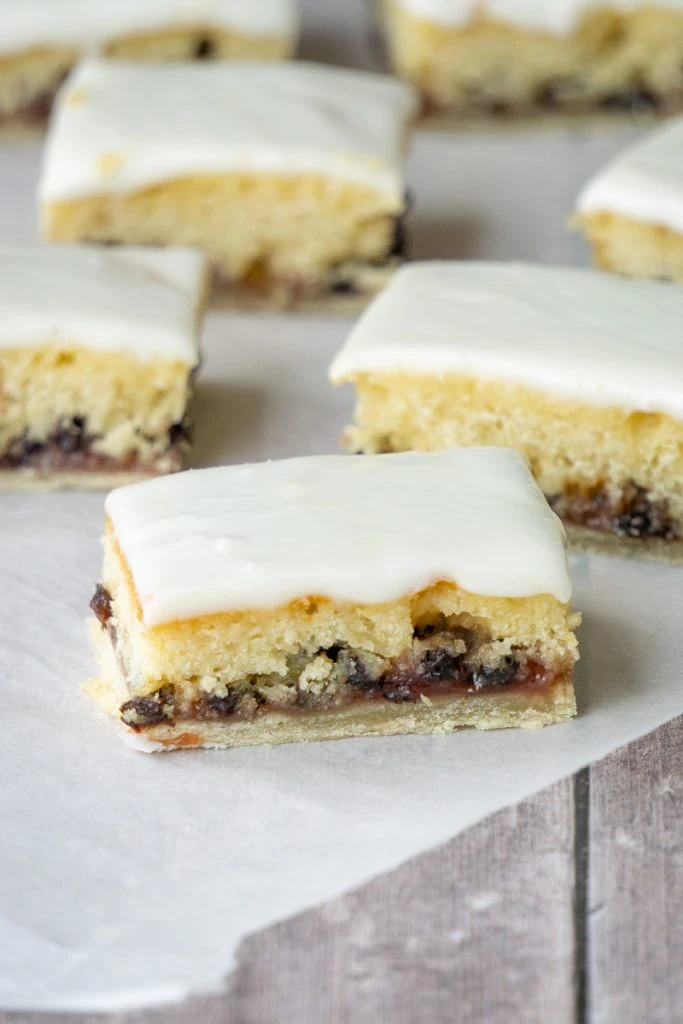
Slice into rectangles or squares depending on your preference.
Then enjoy your Loch Katrine cake, we’d suggest with a cup of tea!
Loch Katrine Cake Recipe
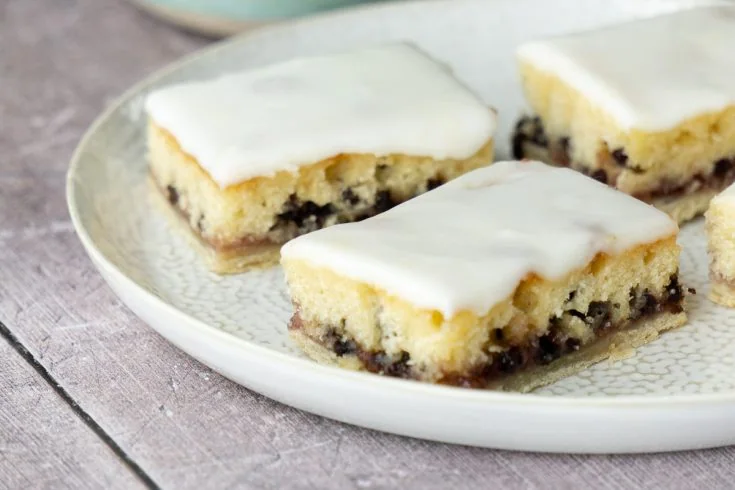
The origin of Loch Katrine Cake may not be Scottish, but the name sure is! This delicious layered slice of pastry, jam, currants, and sponge topped with lemon icing is super simple to make but really delicious.
Ingredients
Base:
- * 190g Plain Flour (1.5 cups)
- * 2 tsp Baking Powder
- * 90g Unsalted Butter, cold and cubed
- * 4-5 tbsp Milk
- * 3-4 tbsp Raspberry Jam
- * 135g Currants (1 cup)
Sponge:
- * 90g Unsalted Butter, room temp
- * 150g Caster Sugar (3/4 cup)
- * 2 tsp Baking Powder
- * 190g Plain Flour (1.5 cups)
- * 3 Medium Eggs
- * 5-6 tbsp Milk
Icing:
- * 350g Icing Sugar
- * 3.5 tbsp Water/Lemon Juice (water for plain icing, lemon for lemon icing)
- * 1 tsp Vanilla Essence (if you are not doing lemon icing)
Instructions
- To start making Loch Katrine cake, we need to begin by making the pastry, which forms the base of the cake.
- Sift the flour and baking powder into a mixing bowl.
- Take your cold, cubed butter and rub it into the flour and baking powder mix slowly, using your fingers, until it resembles breadcrumbs.
- Add milk gradually to make a stiff dough. You may need more or less milk depending on the mix. Work it slowly into the mix, stirring the milk and mixing together with a spoon or your hands. This will help avoid adding too much milk and making your dough too wet.
- Once your dough is well mixed, your next step is to let it rest. Wrap it in cling film and pop it in the fridge for 30 minutes. The reason you wrap the pastry is to prevent it from drying out.
- Grease and line your baking tin with baking paper, ensuring that you focus on the sides of the tin as well as the bottom.
- Roll out your pastry after it's chilled for 30 minutes, then use it to line the bottom of your greased tin. Cut off any excess.
- Spread your raspberry jam evenly over the pastry, lightly covering the entire surface.
- Sprinkle the currants onto the now jam-covered pastry, again trying to ensure an even spread.
- Preheat your oven to 180°C / 160°C for fan-assisted (365°F/320°F).
- In a new bowl, cream the room-temperature butter and caster sugar. Once the mix is creamed into a paste-like consistency, beat in the eggs one at a time.
- Add the flour and baking powder to the bowl and mix them together gently.
- Pour this mixture into the baking tin and spread it evenly over the pastry.
- Bake for 30-35 minutes; all ovens vary slightly. Test the sponge by inserting a knife into it after you think it's cooked and looking to see that the knife comes out clean when removed.
- Allow to cool fully in the baking tin, before icing.
- For lemon icing, mix lemon and water with the icing sugar; for vanilla icing, replace lemon with vanilla essence. Do try it with the lemon icing, it really does add to the taste of the cake.
- Once well mixed together, spread the icing over the sponge thinly while still in the baking tin.
- Allow to set before lifting the cake out of the tin. We used a fish slice very gently to move the cake from the tin to a plate.
- Slice into rectangles or squares depending on your preference.

This looks very much like Albert Cake from back in the day. Definitely going to try it.
Albert cake was round, iced and with a cherry in the middle. 🇨🇦
My mother, long passed, used to make something very similar and called it Florence Cake.
It had a layer of raisins on the pastry base with the sponge on top and finished with plain icing.
Very tasty.
It does sound very similar! We’ll have to look it up.
I think Albert Cake and Florence Cake are the same thing. Very much like the
Loch Katrine Cake, Very nice. I used lemon icing.🇨🇦🥵
What do you do with the 5-6 Tblsp milk listed in the sponge
ingredients? 🤔🤔
What size tin do you use please?
Kiwi here, and this slice has been a regular in my family since the 1960s. I have my English mother’s 1950s Edmonds Cookbook in which this features, which she was given as a new bride because every home should have a copy. We baked it in a much smaller tin so the layers were a lot more generous – no canny Scots economies in those days!
The tradition has now passed to my children, both seasoned bakers and Edmonds devotees.